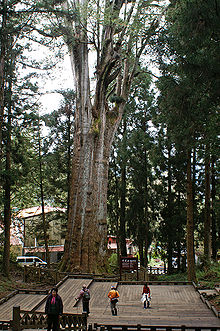| Chamaecyparis formosensis | |
|---|---|

| |
|
Scientific classification
| |
| Kingdom: | Plantae |
| Clade: | Tracheophytes |
| Clade: | Gymnospermae |
| Division: | Pinophyta |
| Class: | Pinopsida |
| Order: | Cupressales |
| Family: | Cupressaceae |
| Genus: | Chamaecyparis |
| Species: | C. formosensis
|
| Binomial name | |
| Chamaecyparis formosensis | |
Chamaecyparis formosensis (Formosan cypress, Taiwan cypress, Taiwan red cypress; [1] Chinese: 紅檜/红桧 hóngguì, Taiwan pron. hóngkuài) is a species of Chamaecyparis, endemic to Taiwan, where it grows in the central mountains at moderate to high altitudes of 1000–2900 m. It is threatened by habitat loss and over-cutting for its valuable timber. [1] [2] [3]
Growth
It is a slow-growing, but long-lived and ultimately large to very large coniferous tree growing to 55–60 m tall with a trunk up to 7 m in diameter. The bark is red-brown, vertically fissured and with a stringy texture. The foliage is arranged in flat sprays; adult leaves are scale-like, 1–3 mm long, with pointed tips, green both above and below with only an inconspicuous stomatal band at the base of each scale-leaf; they are arranged in opposite decussate pairs on the shoots. The juvenile leaves, found on young seedlings, are needle-like, 4–8 mm long, soft and glaucous bluish-green. The cones are ovoid-oblong, 6–12 mm long and 4–8 mm diameter, with 8–16 scales arranged in opposite pairs, maturing in autumn about 7–8 months after pollination. [2]
-
Stringy bark.
-
Foliage and pollen cones.
Related species
It is most closely related to the Japanese Chamaecyparis pisifera (sawara cypress), which differs in smaller globose cones 4–8 mm long with 6–10 scales. [2]
Characteristics
The wood is soft, very resistant to decay, and strongly scented; it is highly valued in traditional Taiwanese building, particularly for temples and shrines. This has led to excessive harvesting, resulting in the species now being endangered. A small number of the oldest and largest specimens are protected as national monuments, but much of the general population of the species still remains unprotected. [2]
Essential oil distilled from its wood is uniquely scented and highly valued. [4]
Notable examples
Sacred Tree of Alishan
The Sacred Tree of Alishan was a 3,000-year-old Taiwan red cypress which died from a lightning strike in 1956. The trunk remained standing until 1998. Due to its sacred status it was left alone by the Japanese when they deforested the surrounding area. [5]
References
- ^ a b c Zhang, D.; Christian, T. (2013). "Chamaecyparis formosensis". IUCN Red List of Threatened Species. 2013: e.T32333A2815341. doi: 10.2305/IUCN.UK.2013-1.RLTS.T32333A2815341.en. Retrieved 17 November 2021.
- ^ a b c d Farjon, A. (2005). Monograph of Cupressaceae and Sciadopitys. Kew: Royal Botanic Gardens. ISBN 1-84246-068-4.
- ^ Flora of China: Chamaecyparis formosensis
- ^ Su, Sharleen. "Distilling Taiwan's Native Scent". www.taiwan-panorama.com. Taiwan Panorama. Retrieved 16 December 2020.
- ^ Cheung, Han (26 June 2022). "Taiwan inTime: Farewell to the divine giant". taipeitimes.com. Taipei Times. Retrieved 28 June 2022.


